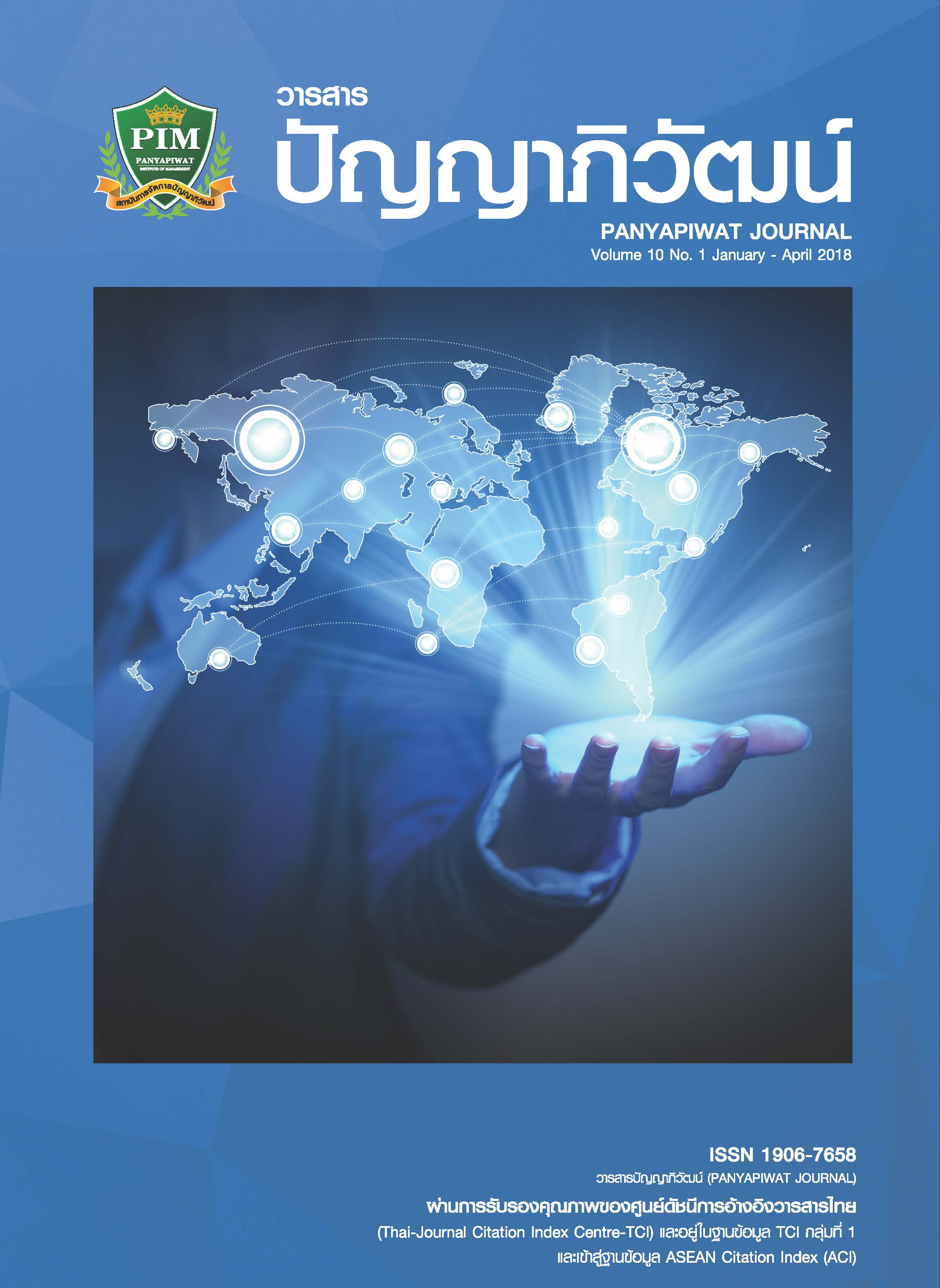การศึกษาความสัมพันธ์ระหว่างปัจจัยสร้างความผูกพัน ระดับความผูกพัน และผลงานของพนักงาน: กรณีศึกษา บริษัท NMO จำกัด
Main Article Content
บทคัดย่อ
การวิจัยมีวัตถุประสงค์เพื่อศึกษา 1) ระดับความผูกพัน 2) ความสัมพันธ์ระหว่างปัจจัยสร้างความผูกพัน ระดับความผูกพัน และผลงานของพนักงาน กลุ่มตัวอย่างเป็นพนักงานบริษัท NMO จำกัด 121 คน เครื่องมือที่ใช้ในการวิจัยคือ แบบสอบถามระดับความผูกพันของพนักงาน วิเคราะห์ข้อมูลด้วยความถี่ ร้อยละ ค่าเฉลี่ย () และส่วนเบี่ยงเบนมาตรฐาน (S.D.) หาค่าความสัมพันธ์ระหว่างปัจจัยสร้างความผูกพัน ระดับความผูกพัน และผลงาน ด้วยค่าสัมประสิทธิ์สหสัมพันธ์เพียร์สัน (Pearson Correlation) ผลการวิจัย พบว่า ปัจจัยสร้างความผูกพันอยู่ในระดับมาก โดยมีค่าเฉลี่ยด้านบุคคลและสังคมในองค์กรสูงสุด (
= 4.01, S.D. = .49) รองลงมาคือ ด้านลักษณะงาน (
= 3.98, S.D. = .45) ด้านสภาพแวดล้อมขององค์กร (
= 3.94, S.D. = .50) ด้านระบบองค์กร (
= 3.70, S.D. = .51) ตามลำดับ ค่าเฉลี่ยระดับความผูกพันอยู่ในระดับมาก (
= 4.13, S.D. = .46) ค่าเฉลี่ยด้านผลงานอยู่ในระดับมากทั้งหมด โดยมีค่าเฉลี่ยด้านผลงานระดับบุคคลสูงสุด (
= 4.08, S.D. =.51) รองลงมาคือ ระดับทีมงาน (
= 4.03, S.D. = .52) และระดับองค์กร (
= 3.93, S.D. = .57) ตามลำดับ วิเคราะห์ค่าสัมประสิทธิ์สหสัมพันธ์เพียร์สันพบว่า 1) ปัจจัยสร้างความผูกพันมีความสัมพันธ์กับระดับความผูกพันอย่างมีนัยสำคัญทางสถิติที่ระดับ .01 โดยที่ปัจจัยด้านระบบองค์กรมีค่าความสัมพันธ์อยู่ในระดับสูงสุด (r = .700) 2) ระดับความผูกพันมีความสัมพันธ์กับผลงานของพนักงานอย่างมีนัยสำคัญทางสถิติที่ระดับ .01 โดยที่ผลงานระดับบุคคลมีค่าความสัมพันธ์อยู่ในระดับสูงสุด (r = .678)
The purposes of this study were to study 1) Engagement Scores 2) Relationships between Engagement Drivers, Engagement Scores and Performance of Employee. The samples were 121 participants who worked in NMO company. The research instrument was employee engagement questionnaires. Data were analyzed by using frequency, percentage, mean () and standard deviation (S.D.). Found the relationship between employee’s engagement drivers, engagement scores and performance by Pearson’s product moment correlation coefficient statistic. The study found that engagement drivers were in high level which is the highest mean was a people/social (
= 4.01, S.D. = .49) followed by a mean of job characteristics (
= 3.98, S.D. = .45), organization climate (
= 3.94, S.D. = .50) and organization practice (
= 3.70, S.D. = .51) respectively. The mean of engagement scores were in high level (
= 4.13, S.D. = .46). The overall performance were in high level, the highest mean was individual performance (
= 4.08, S.D. = .51) followed by a mean of team performance (
= 4.03, S.D. = .52) and business performance (
= 3.93, S.D. = .57) respectively. The analytical of pearson’s correlation found 1) employee’s engagement drivers correlated to engagement scores at .01 statistically significant level, an organization practice had the highest correlation coefficient (r = .700). 2) engagement scores correlated to performance at .01 statistically significant level, an individual performance had the highest correlation coefficient (r = .678).
Article Details
“ข้าพเจ้าและผู้เขียนร่วม (ถ้ามี) ขอรับรองว่า บทความที่เสนอมานี้ยังไม่เคยได้รับการตีพิมพ์และไม่ได้อยู่ระหว่างกระบวนการพิจารณาลงตีพิมพ์ในวารสารหรือแหล่งเผยแพร่อื่นใด ข้าพเจ้าและผู้เขียนร่วมยอมรับหลักเกณฑ์การพิจารณาต้นฉบับ ทั้งยินยอมให้กองบรรณาธิการมีสิทธิ์พิจารณาและตรวจแก้ต้นฉบับได้ตามที่เห็นสมควร พร้อมนี้ขอมอบลิขสิทธิ์บทความที่ได้รับการตีพิมพ์ให้แก่สถาบันการจัดการปัญญาภิวัฒน์หากมีการฟ้องร้องเรื่องการละเมิดลิขสิทธิ์เกี่ยวกับภาพ กราฟ ข้อความส่วนใดส่วนหนึ่งและ/หรือข้อคิดเห็นที่ปรากฏในบทความข้าพเจ้าและผู้เขียนร่วมยินยอมรับผิดชอบแต่เพียงฝ่ายเดียว”
เอกสารอ้างอิง
Allen, N. J. & Meyer, J. P. (1990). The Measurement and Antecedents of Affective, Continuance and Normative to the Organizations Commitment to the Organizations. Journal of Occupational Psychology, 63(1), 1-18.
Allen, N. J., Meyer, J. P. & Smith, C.A. (1993). Commitment to organizations and occupations: Extension and test of a three component conceptualization. Journal of Applied Psychology, 78(4), 538-551.
Anusirikul, N. (2014). Factors affecting employee's relation in turbo garment company limited. Independent study Master of Business Administration, Nation University. [in Thai]
Buchanan, H. B. (1974). Building organization commitment the socialization of managers in work organization. Administrative Science Quarterly, 19, 533-546.
Lukthong, T. (2014). Organizational commitment among employees working for an automotive parts company in amata nakorn industrial estate, chonburi province. Master of Public Administration Program in public and private management, Graduate School of Public Administration, Burapha University. [in Thai]
Luthans, F. (1992). Organizational Behavior (6th ed.). New York: McGraw-Hill.
Mowday, R. T., Porter, L. W. & Steers, R. M. (1983). Employee Organizaton Linkage: the psychology of Commitment absenteeism and turnover. New York: Academic Press.
Robbins, S. P. (2005). Organizational Behavior. Concepts, controversies, and applications (11th ed.). Englewood Cliffs, New Jersey: Prentice-Hall.
Saejueng, T. (2009). Factors affecting organizational affiliation of staff in instructional resource center khon kaen university. Independent study Master of Education Program in Educational Administration, Faculty of Education, Khonkaen University. [in Thai]
Soipetch, P. (2014). Employee engagement: a case Study of employees working in telecommunication and information technology company-engineering department in Bangkok. Master of Business Administration, Nation University. [in Thai]
Yusabai, R. & Boonsong, K. (2017). The comparison of employee engagement level by generation: case study in business furniture group company ABC. Panyapiwat Journal, 9(1), 121-134. [in Thai]
Yusabai, R. (2013). Development of learning dynamic group model for promoting diabetes mellitus patient's health behaviors. Doctor of philosophy program in Technology Educational Department, Faculty of Technical Education, King Mongkut's University of Technology North Bangkok. [in Thai]


